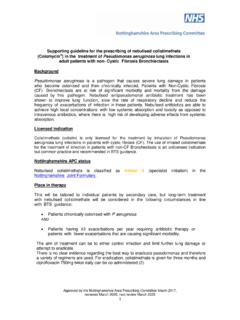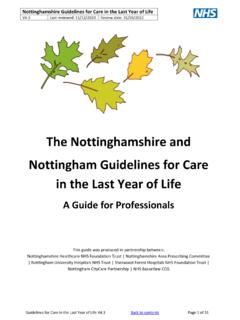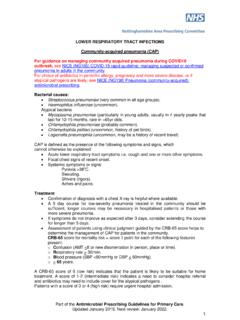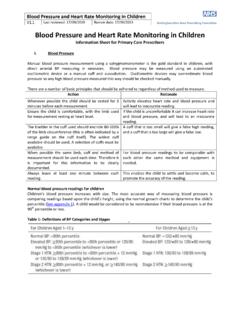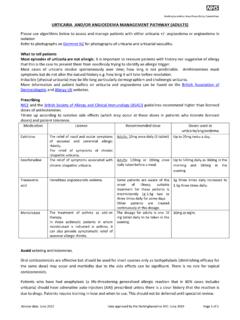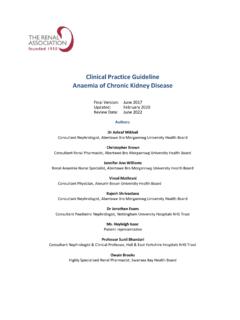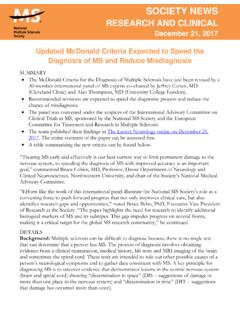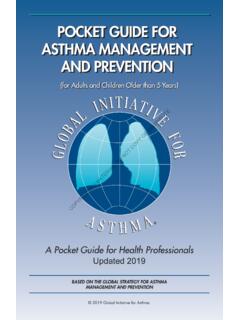Transcription of Heart Failure Traffic Light Treatment Guidelines
1 Author-DrJohn Walsh, Consultant Cardiologist Nottingham University HospitalsApproved by Nottinghamshire APC May 2020, Review Date May 2023 Red Cardiology CareAmber Care sharedGreen Primary Care/Non specialistNottinghamshire Heart Failure Traffic LightGuidelines Nottinghamshire Heart Failure Guidelines reviewed: May 2020 Review date: May 2023 Scope and Purpose The purpose of the Heart Failure Nottinghamshire Lights is to provide local clinical and service guidance for General Practitioners and practice-based staff on the management of people diagnosed with Heart Failure . The Heart Failure Nottinghamshire Lights supports the QIPP workstream on the integrated care pathway for Heart Failure with recommended quality markers developed by the Nottinghamshire Coronary Heart Disease Network Heart Failure Group based on clinical evidence.
2 The Nottinghamshire Heart Failure Lights denote the colours Green, Amber and Red which indicates the clinical /therapeutic and service classification of patients /carers journey along and between an integrated care pathway for Heart Failure and recommendations for treating Heart Failure (NICE 2018). The Heart Failure Traffic Light classification is a simple means of classifying patients into the various potential health sectors delivering Heart Failure , recognising that patients will move between the different sectors at different stages of their journey. PATIENTS MAY BE REFERRED DIRECTLY TO Heart Failure CLINICS AT NUH OR SFH The Heart Failure Nottinghamshire Lights Approved by Nottinghamshire APC May 2020, Review Date May 2023 Page 2 of 15 GREEN defines patients with a CONFIRMED aetiological diagnosis and clinically stable and/or no unscheduled Heart Failure admissions in previous 6 months and on baseline medical therapy.
3 Baseline medical therapy is defined by NICE and includes ACE inhibitors, beta blockers and diuretics. In patients intolerant of ACE inhibitors Angiotensin II receptor blockers (ARBs) are considered an alternative. GREEN PATIENTS MAY BE MANAGED IN PRIMARY CARE BUT CONSIDER REFERRAL TO A SPECIALIST FOR CONFIRMATION OF AETIOLOGY. AMBER classify if clinically unstable patient and/or 1-2 unscheduled admissions in previous 6 months and taking intermediate medical therapy. In-termediate medical therapy will include patients intolerant of baseline therapy and those requiring spironolactone or eplerenone in addition to baseline treatments.
4 Ivabradine requires consideration in patients in sinus rhythm with Heart rate > 75 bts/minute and ejection fraction <35% despite Treatment with beta blockers and optimal baseline therapy. Ivabradine may also be considered in patients intolerant of or unable to take betablockers. Consider cessation of ACE inhibitors or ARB and switch to sacubitril/valsartan (Entresto ) in patients with LVEF<35% who remain symptomatic (NYHA II-IV). Consider dapagliflozin as an adjunct to standard therapy for patients who remain symptomatic on optimised standard care. AMBER PATIENTS WILL USUALLY NEED A COMBINED CARE APPROACH BETWEEN PRIMARY AND SPECIALIST CARE.
5 THIS MAY INVOLVE THE Heart Failure MULTI-DISCIPLINARY TEAM WITH THE SUPPORT OF SPECIALIST Heart Failure NURSES. RED classify if clinically unstable patient and/or more then 2 unscheduled Heart Failure admissions in the previous 6 months on advanced medical therapy. Advanced medical therapy consists of either digoxin (particularly for patients in AF) and/or an ARB and/or prescribed metolazone or bendro-flumethiazide therapy added to baseline/intermediate therapy. RED PATIENTS SHOULD BE CONSIDERED FOR REFERRAL TO CONSIDER PALLIATIVE OR ADVANCED STRATEGIES BIVENTRICULAR PACING, DEFIBRILLATOR Open Access Echocardiogram HF Multidisciplinary Team Integrated HF Service Cardiology Consultants HF Specialist Nurses Health Care of the Elderly Physicians Pharmacist Support Palliative Therapy Multidisciplinary Team Cardiologist GP HF Specialist Nurses Community Nurses Patient & Carers Green Amber Red General Medical or Cardiology Clinics Inpatient Decompensated HF Diagnosis for planning of Management & periodic review HF Clinics follow up +/- HF specialist nurse Specialist Nurse Primary Care clinical Stable with diagnosis confirmed by Echo.
6 And/or no unplanned HF admissions in the previous 6 months THERAPY Baseline therapy: ACE or ARB if ACE intolerant or Hydralazine with nitrate if ACE and ARB intolerance. Beta-blocker Diuretic (if fluid retention) clinical Unstable and/or 1-2 unplanned HF admissions in the previous 6 months THERAPY Intermediate therapy: Failed baseline therapy or On-going baseline therapy AND spironolactone or eplerenone added Consider addition of ivabradine for patients in sinus rhythm, HR >75 beats per minute and ejection fraction <35% Consider sacubitril/valsartan (Entresto ) Consider dapagliflozin clinical Unstable and/or 2 unplanned HF admissions in the previous 6 months, advanced care or palliation to be considered THERAPY Advanced therapy.
7 Addition of digoxin if AF or on-going symptoms despite intermediate therapy Addition of ARB to intermediate therapy Thiazide therapy required in addition to loop diuretics clinical / THERAPEUTIC CLASSIFICATION SERVICE CLASSIFICATION Page 3 of 15 Advanced Heart Failure team Cardiology referral Detailed history and a clinical examination lead to suspicion of Heart Failure diagnosing Heart Failure (1) Assessment of probability 1. clinical History - 4 features History of CAD (MI, PCI, CABG) Hypertension Use of diuretics SOB orthopnoea and PND 2. Physical Examination-4 findings Crepitations Bilateral ankle oedema Heart murmur and/or displaced apex beat Elevated JVP 3.
8 ECG-Any abnormality but especially the following 4: Previous MI or IHD LVH AF Bundle branch block (especially left) Echocardiogram Abnormal BNP levels high or raised No echocardiographic abnormality Normal BNP levels All absent HF with REDUCED EJECTION FRACTION (HFrEF) - LVEF 40% Determine aetiology and start Treatment Consider urgent cardiology referral if BNP >400 Valve disease or other structural abnormality Diastolic impairment Dilated atria/ventricles LVEF >40% HF with PRESERVED (or midrange) EJECTION FRACTION LVEF>40% (HFpEF and HFmEF) Heart Failure unlikely, consider other diagnosis Manage comorbidities- BP, CAD and diabetes Consider referring to cardiology if aetiology unclear (especially age <65years) and/or symptoms persist see diagnosing Heart Failure (2) Initial investigations BNP, CXR, Bloods - FBC, U&E (GFR), LFTs, Thyroid function, Lipids, Glucose (HbA1c), Ferritin, TIBC Brain natriuretic peptides BNP (NTproBNP) High Levels >400 (2000) pg/ml Raised levels 100-400 (400-2000) pg/ml Normal levels < 100 (400) pg/ml Cardiac causes of elevated Brain Natriuretic Peptide (BNP)
9 Heart Failure ACS PE Myocarditis LVH Hypertrophic/restrictive CM Valvular Heart disease Congenital Heart disease Arrhythmias Cardioversion ICD shock Post cardiac surgery Non cardiac causes of elevat-ed BNP Elderly Ischaemic stroke Subarachnoid bleed Renal dysfunction Liver impairment COPD Severe infection Severe burns Anaemia Metabolic Diabetes (DKA) Thyrotoxicosis any of the above present Page 4 of 15 Suspect Heart Failure with PRESERVED (or mid range) EJECTION FRACTION diagnosing Heart Failure (2) Diastolic dysfunction Diagnosis* 1. Symptoms and signs of cardiac Failure 2. LVEF >40% 3.
10 Elevated BNP> 100pg/ml * 4. AND at least one additional criterion: a) Relevant structural Heart disease (LVH, dilated atrium) b) Diastolic dysfunction reported on echo *Normal BNP means HF unlikely but does not completely exclude the diagnosis Confirm dry /target weight Fluid log Teach diuretic self titration on patient s own weighing scales Cardiology Review /Discussion - Refractory symptoms - Increasing severity of symptoms - Thiazide/ IV diuretics to be considered under specialist supervision. Increase diuretic (by one titration step*) - Increase in daily weights >2kg over 2 days - Increased breathlessness - Increased oedema *One titration step = 40mg furosemide or 1mg bumetanide 2 DIURETICS (low to medium dose see Heart Failure medication summary)
